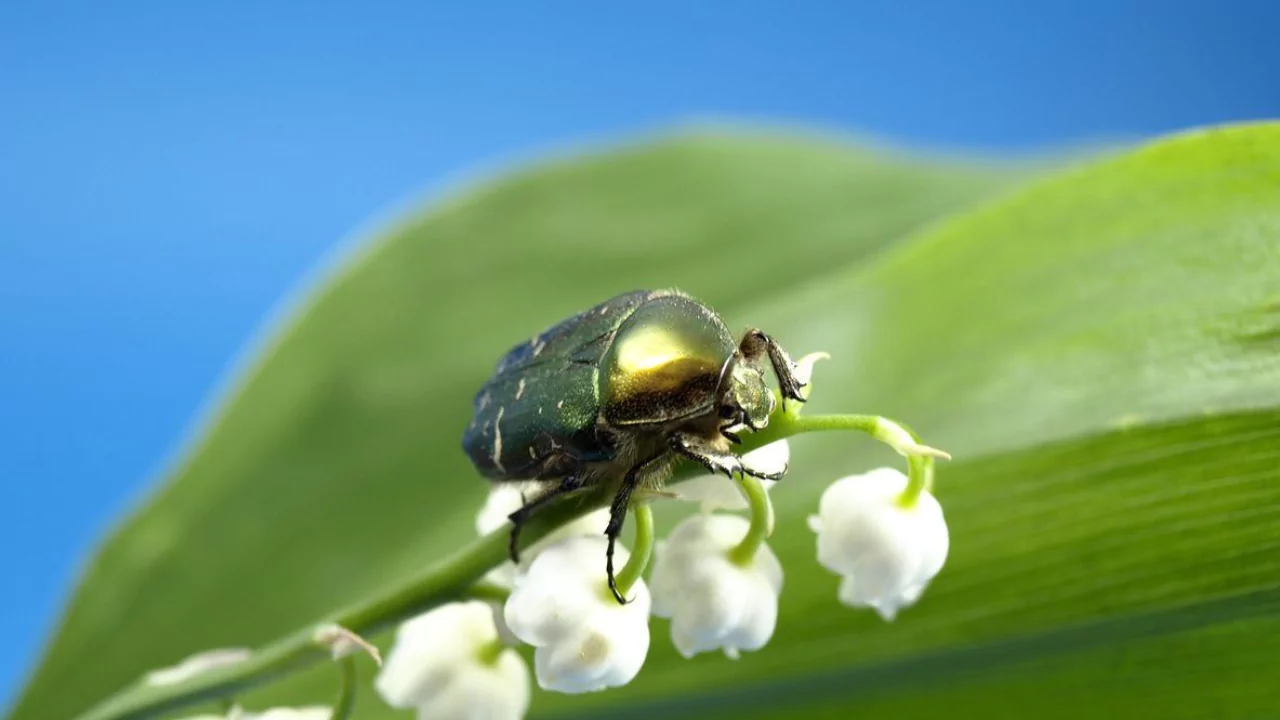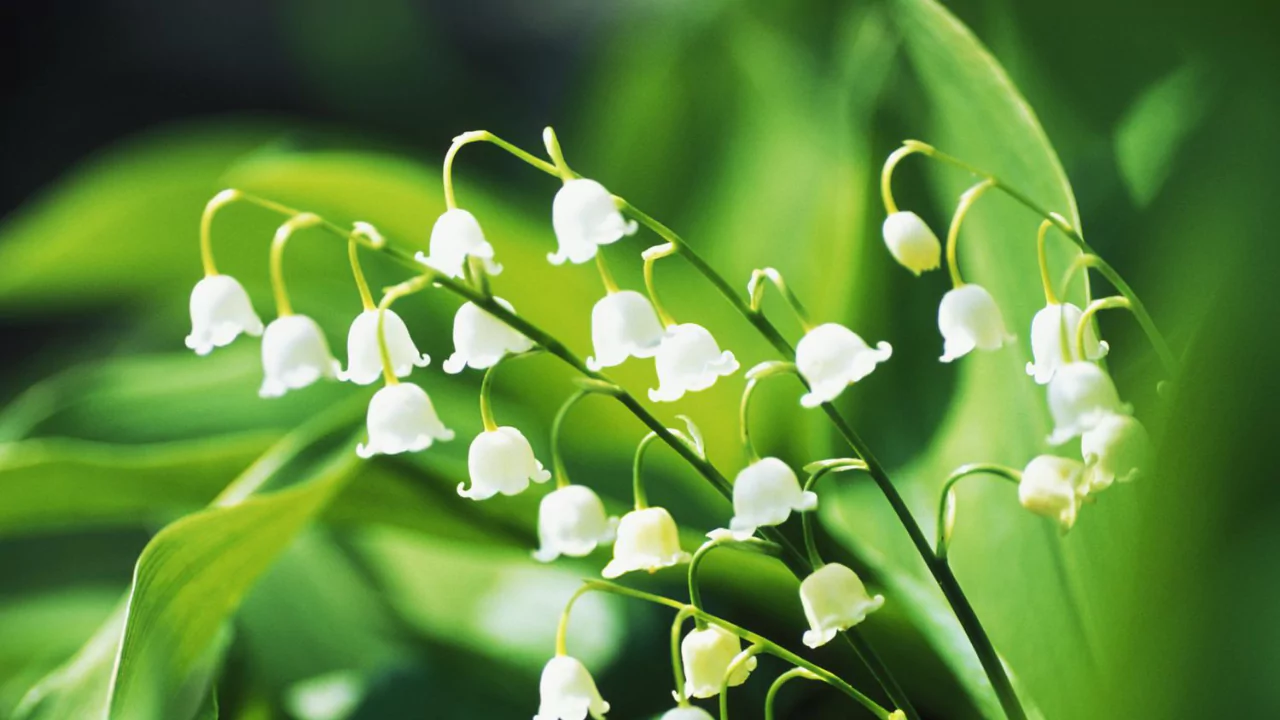Lily of the valley grows in a dense carpet of broad thick leaves, which forms on top of underground rhizomes. During the spring, dainty bell-shaped flowers rest above the leaves in lovely bouquets. Its flowers are also white in color and emit a pleasing fragrance.
“Lily of the valley” derives its name from a Christian fable where the Virgin Mary’s tears, when shed for her son’s crucifixion, were said to give rise to these tears blooms. The French do the lilacs galore mark streamers as part of celebrating the arrival of spring on May 1.

Planting and Caring for Lily of the Valley
There are different methods of planting lily of the valley with division in early spring being the most popular accompanied by nurseries. Rough soils should be mixed with compost and peat moss.
Besides being hardy only to zone 8, the plant does seem to prefer moist and cool climates the most which is why it does well in the Eastern Coast and Pacific Northwest.
Applying a 10-10-10 fertilizer in spring will help lilacs’ growth as it should be spread to a quarter cup per 100 square feet. Liles like dividing their base every two or three years as new lilium stalks appear at centre superficially.
Potential Problems and Pests
To begin with, remember that the entire plant is considered toxic to people and pets alike. If these plants are consumed, breathing problems, vomiting, diarrhea, and a lowered heart rate may occur.
Apart from being toxic, the primary disadvantage of lily of the valley is its invasive nature. It will outcompete most perennials in a vigorous spread during the ideal climate.
In terms of pests, deer are known to be quite a problem. Slugs and snails, however, are more than willing to dine on some of the plant’s foliage, especially in moist soils. If slug populations are a concern, you can control the problem by removing some of the mulch and allowing the soil to dry out.
Lily of the valley may be infested with stem rots and leaf spots. It is better to propagate lily of the valley in well-drained soil and use drip systems instead of overhead irrigation.

Cultivars Worth Trying
- ‘Albostriata’ has interesting white-striped foliage.
- Most cultivars remain under 12 inches tall, but ‘Fortin Giant’ grows up to 15 inches tall.
- ‘Rosea’ has lovely pink flowers, rather than the classic white blooms.
Can lily of the valley kill you?
All parts of lily of the valley contain toxic substances, and their complete poisoning can lead to death. Children, pets, and even adults can die from consuming lethal doses of these toxins. As small an amount as two leaves is enough to kill children and pets.
Can you grow lily of the valley in pots?
Yes, pots containing lily of the valley can be kept indoors or outdoors in their growing zones, which range from three to eight on the USDA scale. Growing containers can help control the spread which makes some gardeners refrain from attempting to cultivate it.
One or two inches separating rhizomes should be planted in a standard potting mix, and placed within the container at a location with indirect bright sunlight and a temperature of 60 to 70 degrees Fahrenheit.
Can you grow lily of the valley indoors?
As long as met. Requirements, lily of the valley needs can be grown indoors, yes. These containers should be deeper than wide in order to accommodate the long roots of the plant. They should also feature holes for drainage.Cover the rhizomes to the buds with a standard potting mix and move the pot to somewhere with bright, indirect sunlight.
Can you root lily of the valley?
Instead of using a cutting, you propagate new plants from an already established plant using the division method. Division of the plant can be done in early spring or fall, four to six weeks before the expected first frost, when the plant is dormant.
Dig around the plant for about six to eight inches. Any unset rhizomes should be thrown away if they are slimy, discolored, or otherwise unhealthy.
Do deer eat lily of the valley plants?
Since the plants are poisonous, deer tend to avoid feeding on the lily of the valley.
Do lily of the valley like sun or shade?
The most favorable location for planting the lily of the valley is a spot with partial shade. If the amount of water is carefully managed, the plants can adapt to full sun or full shade.
Do lily of the valley plants spread?
If left uncontrolled, yes. Lily of the valley is considered invasive and will spread aggressively.
Do slugs eat lily of the valley?
Yes, both snails and slugs do partake of the lily of the valley, munching holes in its leaves. If you would like to know more, feel free to read our article on Slug and Snail Pest Control.
How big does lily of the valley get?
The height of the plants ranges from six inches to a foot tall.
How deep do I plant lily of the valley?
The correct planting depth is to cover the buds at the top with soil.
How do I get rid of the lily of the valley in my garden?
Manually pull out the visible plant and all the rhizomes that are above the soil line. With the aid of a rake, sift through the soil to remove any broken rhizome fragments and dispose of these as well.
How do you fertilize lily of the valley?
Every year, most people apply 10-10-10 blended fertilizer granules to the soil and mark their calendars with the words “Follow Instructions.”
How do you transplant lily of the valley?
To propagate ‘lily of the valley’, ‘divide the plant in spring or autumn while it’s dormant. To prevent damaging the underground rhizomes, dig roughly six inches around the perimeter of the plant. Remove the clumps from the soil, divide them into several parts, and plant each part in a new spot four to five inches apart.
How do you winterize lily of the valley?
Remove any dead or dying foliage, and then place a one-inch layer of compost or aged manure on top of the plants. This will nourish the soil for the upcoming growing season while also keeping the plants protected from the cold.
How far apart do you plant lily of the valley?
When planting individual young plants or rhizomes, leave five or six inches of space on each side. For a clump of rhizomes, space them one or two feet around each side.
How long does it take for lily of the valley to spread?
‘Lily of the valley’ is known to be quite fast spreading – in fact, it is believed to double its area of spread yearly.
How long do lily of the valley bloom?
Beginning in mid-spring, lily of the valley plants bloom for a period of three to four weeks. If grown indoors, it can bloom out of season.
How often do lily of the valley bloom?
Lily of the valley blooms once every year, typically from March to April, for a duration of three to four weeks. When cultivated indoors, they tend to bloom out of season.
How often do you water lily of the valley?
When the soil where the lily of the valley is planted dries out to one to two inches below the surface, give it one inch of water. The moisture level of the soil can be checked by putting a finger into the soil.
Is it OK to touch lily of the valley?
Touching the flower is harmless because all parts of the lily of the valley plant are poisonous if consumed, but it is not harmful when touched.
Is lily of the valley poisonous to humans, dogs, or cats?
Lily of the valley is very highly toxic to both humans and animals. The ingestion of at least two leaves is capable of causing death to infants or pets, and while adults would have to consume a greater quantity to be fatal, it is still possible.
Should I deadhead lily of the valley?
To promote further planting and enhance aesthetics, deadhead lily of the valley by cutting off the stems of the flowers which are starting to wilt.
What conditions does lily of the valley like?
Lily of the valley enjoys being in partial shade, but with some changes in watering it is able to withstand full shade to full sun. Our spacing often prefers moist, well-drained soil and should have an inch of water when the uppermost one or two inches of soil has dried out.
